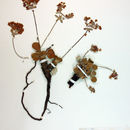Comments
provided by eFloras
Eriogonum lobbii is rather infrequent throughout its range. It is found in three widely scattered areas of concentration: the high mountains of northwestern California and southwestern Oregon; the southern portion of the North Coast Range of California; and the Sierra Nevada of eastern California and west-central Nevada. In the first two areas, the plants frequently are associated with serpentine soils; elsewhere the species is found almost exclusively on granitic soils and infrequently on volcanic ones. There are some morphologic differences between the Sierran plants and those of the coastal mountains, but no taxonomic separation is suggested. The species is a food plant for the intermediate dotted-blue butterfly (Euphilotes intermedia).
- license
- cc-by-nc-sa-3.0
- copyright
- Missouri Botanical Garden, 4344 Shaw Boulevard, St. Louis, MO, 63110 USA
Description
provided by eFloras
Herbs, compact or sprawling, matted, 0.3-3 × 1-2.5 dm, tomentose to floccose. Stems: caudex absent or nearly so; aerial flowering stems prostrate to decumbent or weakly erect, slender or stout, solid, not fistulose, usually arising directly from a taproot, 0.5-1.5(-2) dm, tomentose to floccose. Leaves basal, in well-defined rosettes; petiole (0.8-)1-3.5(-5) cm, tomentose to floccose; blade ovate to obovate or round-oval, 1-4(-5) × 1-4(-5) cm, densely white- to grayish- or reddish-tomentose abaxially, less so to floccose or glabrous and greenish adaxially, margins entire, plane. Inflorescences subcapitate to umbellate or infrequently 2-umbellate, 1-4 × 1-4 cm; branches tomentose to floccose; bracts 3-5 at proximal node, leaflike, 0.6-1.5(-2.5) × 0.1-0.5(-0.8) cm, sometimes absent immediately below involucre. Involucres 1 per node, turbinate-campanulate to campanulate, 5-10(-12) × 5-10(-12) mm, thinly tomentose to lanate; teeth 6-10, usually lobelike, mostly reflexed, 2-6 mm. Flowers 5-7 mm, including 0.1-0.4 mm stipelike base; perianth white to rose, glabrous; tepals monomorphic, oblong-obovate; stamens exserted, 5-7 mm; filaments pilose proximally. Achenes light brown to brown, 4.5-6 mm, glabrous. 2n = 40.
- license
- cc-by-nc-sa-3.0
- copyright
- Missouri Botanical Garden, 4344 Shaw Boulevard, St. Louis, MO, 63110 USA
Habitat
provided by eFloras
Gravelly to rocky or talus slopes, mixed grassland, buckbrush, manzanita, and sagebrush communities, montane, subalpine, or alpine conifer woodlands; (1000-)1600-3800m.
- license
- cc-by-nc-sa-3.0
- copyright
- Missouri Botanical Garden, 4344 Shaw Boulevard, St. Louis, MO, 63110 USA
Eriogonum lobbii: Brief Summary
provided by wikipedia EN

Eriogonum lobbii plant with downhill-drooping yellow-green flowers
Eriogonum lobbii is a species of wild buckwheat known by the common name Lobb's buckwheat or prostrate buckwheat. It is native to most of the mountain ranges of northern California and their extensions into Oregon and Nevada. It is found in a number of mountain plant communities.
The plant is named after William Lobb (1809–1864), the English plant collector.
- license
- cc-by-sa-3.0
- copyright
- Wikipedia authors and editors


 Eriogonum lobbii plant with downhill-drooping yellow-green flowers
Eriogonum lobbii plant with downhill-drooping yellow-green flowers